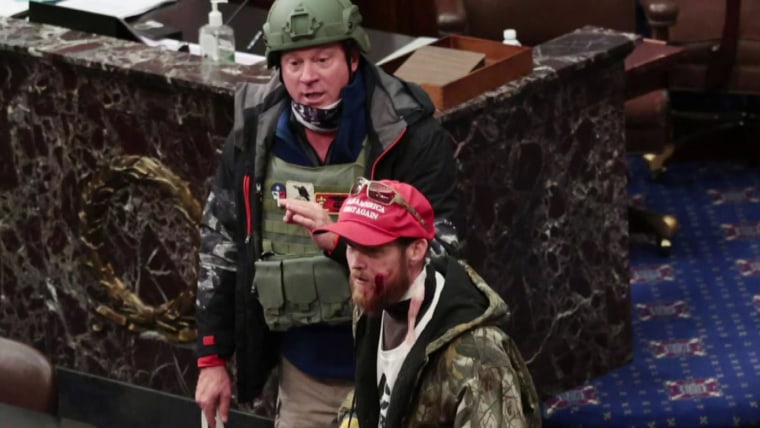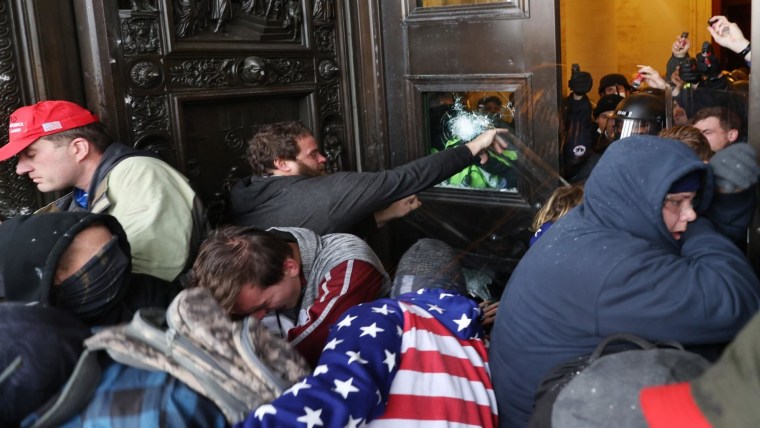[ad_1]
WASHINGTON — The FBI and the New York City Police Department passed information to U.S. Capitol Police about the possibility of violence during the protests Wednesday against the counting of the Electoral College vote, and the FBI even visited more than a dozen extremists already under investigation to urge them not to travel to Washington, senior law enforcement officials said.
The previously unreported details undercut the assertion by a top FBI official that officials had no indication that violence was a possibility, and they add to questions about what intelligence authorities had reviewed before the Capitol riot, which led to the death of an officer and four other people, including a rioter who was shot and killed by police.
“Social media is just part of a full intelligence picture, and while there was First Amendment-protected activity on social media to include some people making threats, to this point, investigators have not found that there was an organized plot to access the Capitol,” a senior FBI official said.
It was immediately obvious after the Capitol was seized by a violent mob Wednesday that Capitol Police, whose job is to defend the facility and the lawmakers who work there, had completely misjudged the security threat. The chief of the force was quickly forced out of his job, as were other key legislative security officials.
As evidence mounts that some extremists had told the world what they had in mind through social media, questions are emerging about whether the FBI, the Department of Homeland Security and other federal agencies took the postings seriously enough — and why, if they did, they didn’t step in until well after the building was under attack.
Asked Friday whether the slow police response Wednesday was the result of an intelligence failure, the official who leads the FBI’s Washington field office, Steven D’Antuono, said no. “There was no indication that there was anything [planned] other than First Amendment-protected activity,” he said.
D.C. Police Chief Robert Contee said something similar Thursday, telling reporters, “There was no intelligence that suggested there would be a breach of the U.S. Capitol.”
Ken Rapuano, the assistant secretary of defense for homeland defense, told reporters that the Justice Department and other law enforcement officials told the Defense Department repeatedly that they had no indications that there would be “significant violent protests.”
But there were ample indications of potential violence.
NBC News has reported that a digital flyer made public on Instagram and Facebook last month referred to what would happen as “Operation Occupy the Capitol.”
On the fringe message board 8kun, which is popular with QAnon followers, users talked for weeks about a siege of the Capitol.
“You can go to Washington on Jan 6 and help storm the Capitol,” an 8kun user said Tuesday, a day before the siege. “As many Patriots as can be. We will storm the government buildings, kill cops, kill security guards, kill federal employees and agents, and demand a recount.”
Daniel J. Jones, president of Advance Democracy Inc., a global research organization that studies disinformation and extremism, told NBC News in a story published the day before the riot: “In regard to the protests planned for Jan. 6, the violent rhetoric we’re seeing online is at a new level. There are endorsements of violence across all of the platforms.”
How could the FBI and other agencies have missed all that? It turns out they didn’t, officials said.
“Prior to this event, the FBI obtained credible and actionable information about individuals who were planning on traveling to the protests who expressed a desire to engage in violence,” the senior FBI official said. “The FBI was able to discourage those individuals from traveling to D.C.”
The official added that “the FBI and our federal, state and local partners collected and shared available intelligence in preparation for the various planned events.”
“The FBI was prepared to adapt as needed to fluid events on the ground, including having rapid response teams in reserve,” the official said. “Throughout most of the day the crowd was peaceful and nonconfrontational.
“However, when it became clear that some individuals were surging onto the Capitol grounds and entering the buildings, the U.S. Capitol Police requested assistance. Within 50 minutes of that request, three FBI tactical teams were on scene to gain control of the area and offer protection to congressional members and staff. Over the course of the evening, the FBI presence ultimately grew to over 150 agents and other personnel.”
The official wasn’t in a position to explain why D’Antuono, the head of the Washington field office, said there had been no indications of violence.
The FBI official said that by dissuading some extremists from traveling to Washington, the bureau may have prevented an even more violent situation.
New York police, who have the most robust intelligence collection and analytical arm of any local police agency in the country, sent law enforcement agencies across the country — including Capitol Police — an intelligence packet describing threats and violent rhetoric on social media in the weeks and days leading up to the rally, multiple senior law enforcement officials said.
The officials said Capitol Police were given a specific and separate intelligence report describing extremist rhetoric and threats of violence that appeared on social media in connection with the rally.
Law enforcement officials familiar with the intelligence assessments said President Donald Trump’s exhortation of the crowd to march on the Capitol probably prompted a much larger contingent of people to head there than might otherwise have gone.
Capitol Police and the FBI’s Washington field office didn’t immediately respond to requests for comment.
It wasn’t just police agencies that issued warnings. A private intelligence report issued in December, obtained by NBC News, said the “‘million-MAGA march’ in Washington DC on 6 January is the next major flashpoint … the mass event (which will be held in the National Mall and outside the Capitol) is likely to spark street violence, some of which may be lethal, between Antifa and Trump supporters or far-right groups.”
Many questions remain about why the FBI, Homeland Security and other agencies didn’t do more to make sure the Capitol was protected. Officials have said Capitol Police reassured everyone that they could handle the situation, and key lawmakers said they heard the same assurances from the force.
The Metropolitan Police Department in Washington is responsible for crowd control in the city, and the mayor told Justice Department officials that she didn’t want or need their help. While city police helped retake the Capitol, they were unable to stop the crowd from getting there in the first place.
The FBI is also under scrutiny. Its top investigative priority is terrorism, foreign and domestic. Had this been an al Qaeda plot to storm the Capitol, some experts said, it is likely that the FBI would have arrested the participants before they left their home airports on the way to Washington.
One difference, however, is that there is no domestic terrorism statute, which gives the FBI fewer avenues to legally monitor suspects, including their postings on the dark web, said NBC News contributor Frank Figliuzzi, a former assistant director of the FBI.
Outside a criminal investigation of a specific person or group, Figliuzzi said Saturday, “the FBI is not permitted to look and monitor the very same things that you and I can look at on Twitter and Parler.”
Joyce Vance, a former U.S. attorney for northern Alabama, said the FBI has tools to monitor potential violence by domestic extremists. She suggested that the issue was one of emphasis and will.
“The challenge for FBI and DOJ is to assign a permanent priority to domestic white supremacist terror groups and treat them as seriously as they treat foreign terrorism,” she said.
[ad_2]
Source link

